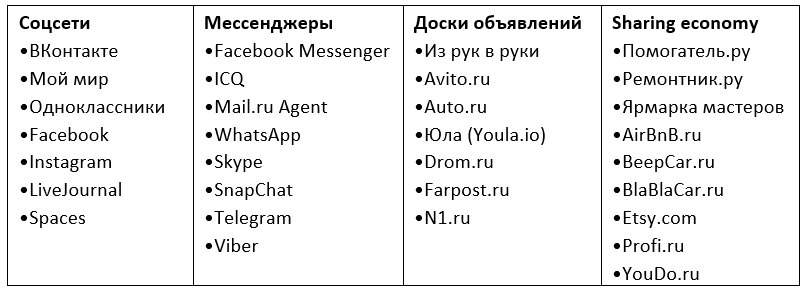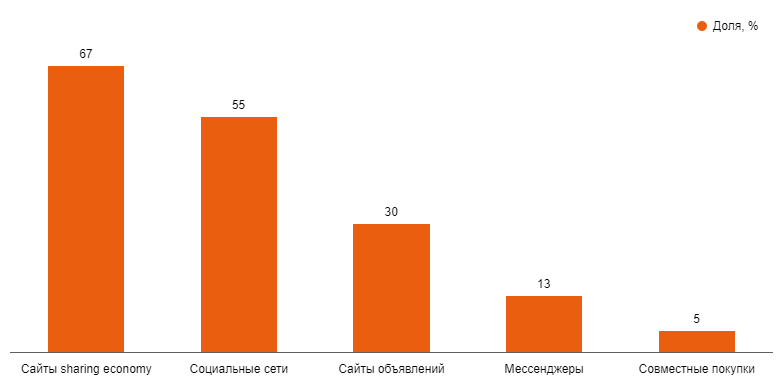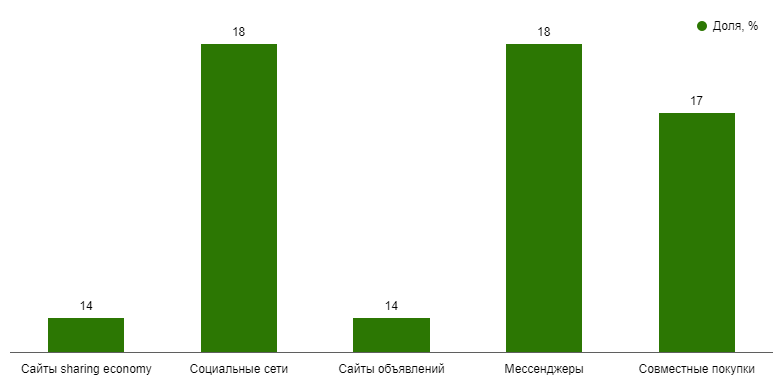
Publication date: 15 May 2019
S-commerce on messengers and social networks
A growth in the number of websites which accept online payments started slowing down two years ago, researchers at the Marc company noticed. Does it mean that e-commerce is getting less popular? No, it does not. Small and medium-sized businesses have started selling on social channels (social media, messengers, online bulletin boards, etc.) rather than on their websites. Sellers are meeting customers’ needs, and customers are reciprocating.
How is consumer buying behavior changing in this context?
The popularity of online shopping seems to be close to its “natural maximum”. A Data Insight and Yandex.Kassa research showed that 79% out of 3,000 internet users surveyed bought a good or a service online at least once in the last 12 months. The researchers calculated that the number of online shoppers amounted to 56 million people. 70% of them, or 39 million internet users aged 14-54, made at least one purchase on a social channel. It has become relevant to introduce a new S-commerce term, in which S stands for “social”. The researches put all main social channels together into four platforms and offered respondents to choose only from them. Purchases made outside these platforms, including in-game purchases and purchases in the real estate and car sectors, were not taken into account.
Platforms and social channels
They do buy and will continue buying
Social networking is the acknowledged leader among online activities of users. It takes the lion’s share of users’ time spent online. However, online purchases more often are made on so-called sharing economy websites.
Users’ activity on channels
The situation might change soon that is supported by respondents’ answers about expected purchase frequency on a particular channel. Questions about a particular channel were addressed only to those users who had already made purchases on it. Results of the survey show that social networks are likely to gain the upper hand, and messengers might bring some surprises. As for online bulletin boards, there still are and will be loyal users, the number of which, however, is unlikely to increase significantly.
Will it be easier to make such purchases in the future?
Social channels have growth potential: every fourth of those people who have already used them but have not made purchases on them replied affirmatively that “(s)he would like to try”. The same number of people said the same but was less certain: “rather yes”, and only 4% are sure that they will not make such purchases.
Why they do not buy?
Why do many of those who use channels buy nothing on them? The main reason is concern over the quality of goods (29%). The assortment of goods, prices, and everything that might be referred to in such cases come in the second place (8%). It should be noted that any inconveniences which users might face with during online shopping and interface developers often talk about are seen as an obstacle only by 7% of users.
How do people make purchases in social networks?
In social networks, most buying scenarios (from 25% to 50% of transactions) are “planned”. At the same time, less than a quarter of all purchases were made when users were searching for particular goods or services. For example, users entered search queries for goods and services in social networks (17%), visited a saved website of a seller (5%), or searched for a relevant group to make an order (5%).
The most popular buying scenario in social networks (23%) was to buy goods in a specialized group. The researchers point out that these purchases might be either planned or spontaneous.
Messengers have become some kind of social networks, but everything works differently there. They most often are used for communication between the buyer and the seller. Purchases via messengers start on a seller’s website or on a social network, where the client chooses a good or a service. Then, the seller and the buyer use the messenger to discuss details of the purchase.
The following variants are possible but happen more rarely:
- the buyer chooses the seller and the good in the messenger. This is a buying scenario for channels, groups, chatbots, direct messages.
- the buyer makes a purchase after (s)he has received a promotional offer on the messenger (newsletter, banner).
Share it with your friends via favorite social media
































